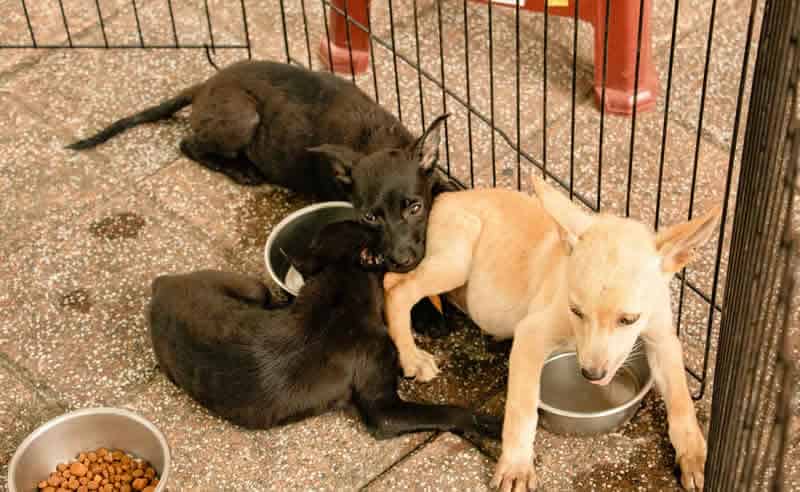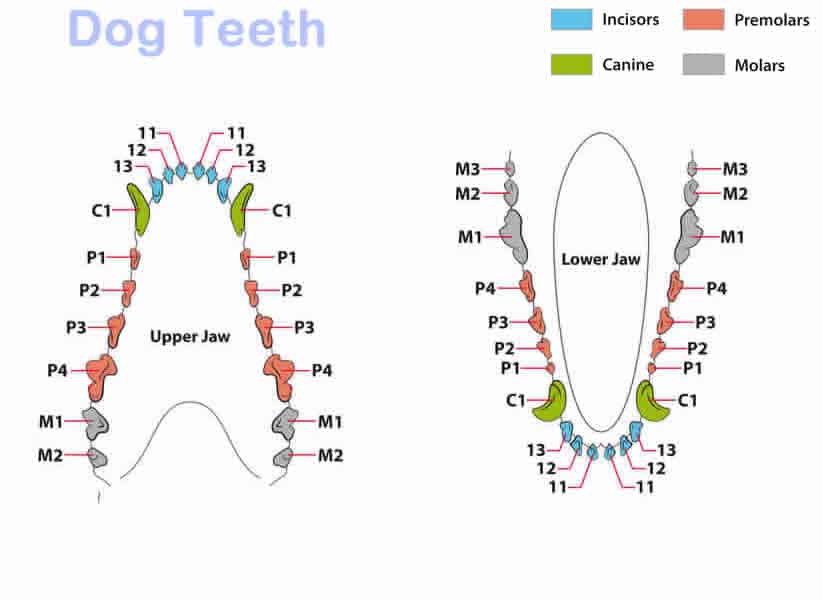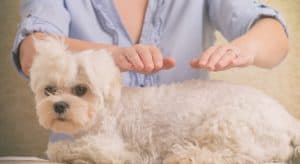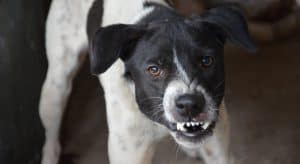If you are a first-time dog owner especially with a young puppy you might be asking the question “when will my puppy stop biting”. It can be a real worry for some new owners as they may begin to think that my new puppy will grow up to become a vivacious biting bully. Don’t forget that your pup’s baby teeth are like sharp little razors and they can hurt too! So if a cute little pup starts to bite and mouth it’s no wonder new dog parents might even be scared of their new pup.
Well, thankfully puppy biting is a short-term phase that almost all puppies go through. By the time your puppy reaches the grand old age of 6 months, the biting should cease when the adult teeth are present.

Why Does My Puppy Bite?
Normal Puppy Behavior
Well, firstly puppy biting is a normal activity that all pups engage in. It’s a perfectly normal canine behavior. From the moment puppies are born they are surrounded by their siblings. They all engage in the rough and tumble of puppy play. They use their mouths the way we use our hands. They will grab ther siblings wit their mouth and bite, pull and tug.
Attention Grabber
Puppies can also use their teeth to grab attention. Although from a human perspective there are better ways to gain your attention. but a puppy will
Explore & Taste New Things
Puppies use their mouth and teeth to explore new things and objects. It’s the same for humans too. You always have to be careful around toddlers and babies – not that they will bite you like your dog although it can happen – you need to make sure they don’t shove anything into their mouth to taste or to ease the gums when they are teething. Well, it’s the same for puppies. They chew and bite things to explore and taste new things as well as ease the pain of teething. Puppies will pick objects up in their mouths as part of their discovery.
Teething in Puppies
Teething can be quite painful. The new adult teeth are pushing through the gums and sometimes there can even be a little bit of blood. When puppies chew and bite it can provide some comfort against the teething pain.
Puppies are not born with any teeth but within 2/3 weeks the baby (deciduous) teeth start to appear and by 6 weeks all the new teeth are in place.
How Many Teeth Does A Puppy Have?
| Time | Description |
| Puppy’s Birth | Puppies are born with no visible teeth |
| 2/3 Weeks | Baby (Deciduous) Teeth begin to show through the gums |
| 6 Weeks | All baby teeth should be visible for most puppies |
| 12 weeks | Baby teeth begin to fall out |
| 6 Months | Most puppies will have their adult teeth |
From the above chart, you will see that puppies are born with no visible teeth. They are also born blind and deaf and rely totally on their smell sense to be near their mother while nursing.
Around 2/3 weeks of age, your puppy’s baby or deciduous teeth begin to show through the gums and his eyes will open. At 6 weeks most of his baby teeth should also be visible and also at this stage, the breeders usually start weaning puppies with soft moist dog food. When all the baby teeth have descended there should be 28 teeth in total. Puppies do not have any molars at this stage.
At 12 weeks of age, your puppy’s baby teeth will start to fall out. Puppy teeth are sharp razor comb-like and during this phase, many new dog owners do not even notice these baby teeth as most pups end up swallowing them. So don’t be alarmed if you spot any little on the floor. Also, you may notice some small blood stains on your pup’s toys. Again it’s nothing to worry about but if you are ever concerned about your pup’s health seek professional advice from your veterinarian.
At 4 months of age, the milk teeth will begin to fall out and will be replaced by adult teeth. At 6 months of age once all the adult teeth have descended the molars make their appearance.
How To Deal With Puppy Biting
It can be frustrating for new dog owners to cope with puppy biting. We always advocate the use of positive dog training methods.
The most important thing to remember is that never use harsh and outdated dog training methods to deal with a puppy biting as this will most definitely make things worse and you could end up with a frightened, nervous, or even an aggressive puppy.
A research paper from the University of Pennsylvania conducted a survey on confrontational and non-confrontational dog training methods. Based on this, they found those dog owners who tried aversive dog training techniques may end up provoking fearful and defensively aggressive behavior in dogs. These controversial and somewhat cruel methods included hitting or kicking a dog for undesirable behavior, growling at the dog, alpha roll, staredowns, etc. So never use any of these methods to deal with a puppy biting as you could end up either making your puppy frightened, scared, and aggressive.
Instead, there are several ways you can deal with puppy biting
Loud Yelp Sound
Some trainers advocate letting a loud yelp when the puppy bites hurt. Puppies normally respond to yelping sounds. However, if your puppy does not respond to this then try saying “No” in a stern voice and remove your hand immediately.
Withdraw from Situation
When the pup bites, you can immediately withdraw from the situation and refuse to engage with the pup for at least 10 minutes. The puppy will soon learn that biting will mean no attention or play.
Turn Hand Sideways
If a puppy comes over for a treat and then tries to bite your hand, quickly turn your hand sideways to avoid the teeth and refuse to give the treat until the biting stops.
Chewy Toys Available
Whenever you are playing with your puppy it is advisable to always have a chewy toy available on hand. If the puppy tries to bite you then take the toy and show it to the pup instead of your fingers.
No Rough Play with Biting / Hand Wrestling
Do not play games that encourage your puppy to bite. These games include rough play and hand wrestling. It’s only natural that a pup will go after nice dangly fingers.
Puppy-Proof Home
Puppy proof your home as much as you can. If your hand is not available for chewing your puppy will find something else to chew from shoes, sneakers, furniture, etc. They are just teething and will chew on anything that will provide some relief.
The Makeup of Teeth in Dogs

Incisors
Dogs have 12 incisor teeth. These teeth are the small ones at the front of the mouth. There are 6 incisors on the top and 6 incisors on the bottom of the mouth. If a dog could smile these are the teeth that would show.
Dogs use their incisor teeth when they need to grab hold of items such as toys or food. They also can use their incisors to bite into food and they are useful to scrape meat from bones. You may also have noticed that your dog uses his incisors whenever he is trying to groom himself or when attempting to remove debris from his coat.
Canines
Dogs have 4 canine teeth and they are located at the front of the mouth just behind the incisors. Two are at the top of the mouth and the other two at the bottom. Canine teeth in dogs are long and pointed teeth. They are sometimes called the eye teeth or more commonly known as the fangs. Dogs use their canine teeth to hold onto objects and also for puncturing.
Premolars
Dogs have 16 premolars and they are located behind the canine teeth. There are 8 premolars on the top of the mouth and the other 8 are on the bottom. Premolars are sharp and dogs use these teeth for chewing and shredding food. If you ever notice your dog chewing a bone with the side of his mouth he is using his premolars.
Molars
Dogs have 10 molars and they are located at the back of the dog’s mouth behind the premolars. There are 4 molars on the top o the mouth and 6 molars on the bottom. Dogs’ molars are quite similar to human molars. They are used to grind and break down food that needs to be chewed.
Sources
- https://www.oakvillevets.com/blog/789-canine-teeth
- https://www.purina.co.uk/dentalife/dental-advice/dog/article/canine-dental-anatomy
- https://www.akc.org/expert-advice/health/timeline-of-puppy-teething/
- https://vet.osu.edu/vmc/sites/default/files/import/assets/pdf/hospital/behavior/trainingArticle.pdf







